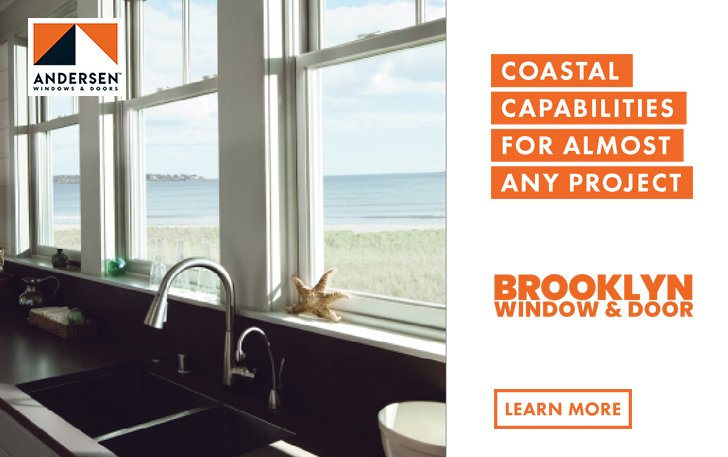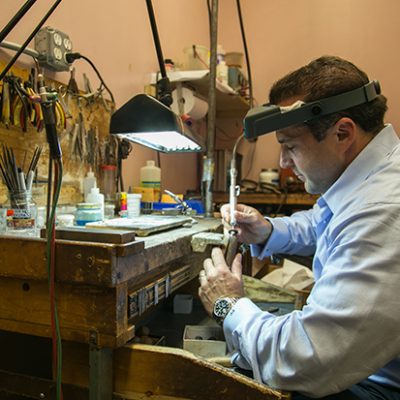THE OWNER OF WILLIAMSBURG RETAIL MAINSTAY TIVOLI JEWELERS, ON THE ART OF HAND-CRAFTING, THE DANCE OF THE DEAL, AND WHAT IT TAKES TO SURVIVE IN THE JEWELRY CAPITAL OF THE UNITED STATES
Industry: I couldn’t help but notice, but you have that unmistakable city twang.
Frank Palmeri, Jr. [registered Jeweler]: Yes [laughs]. I grew up in Queens, in Glendale. My mom still lives in the same house there, though my family traces its lineage back to Sicily. I moved to the suburbs a while ago, so I live on Long Island now.
Industry: And how does a Glendale kid find himself the owner of a two-decade-old jewelry business?
FP: I started working part-time in college for a manufacturer. Someone I knew who was already in the industry said that if I could learn enough about the business, then he would hire me, So I worked for a time at a company called Scientific Casting, which is now closed. About a year after I arrived, they went out of business, but I stayed in the industry, because I truly loved it. I always liked working with my hands more than the academic work in college. After learning about the casting business, Itook some setting classes…learned to set stones. Through a placement program, school got me into some other manufacturing shops. At each subsequent place, I learned something that allowed me to move on. Through contacts and networking, I started working as a jeweler to other stores, where I would
go to one on Monday, another on Tuesday, and during each day would do all of their repairs and manufacturing for the week. Sort of a subcontractor.
Industry: A freelancers life…
FP: With all of the advantages and disadvantages [laughs]. But
as I went from store to store, I realized that a lot of the owners knew less than I did. I would have to go to the front and answer questions and come up with prices, even though I was
supposed to be their bench jeweler. I thought, “I could probably do this better myself, and get paid what I’m worth on top of it.” In 1992, a friend of mine let me know about this particular location, 325 Grand Ave. [now 327], and we’ve been here 22 years.
Industry: With what must be hundreds of storefronts worth of competition in the city alone, what was the peg you wanted to hang your new business on?
FP: I thought I had better ideas about how to do a great many things. I wanted to offer better standards. We are an AGS jeweler, which is the American Gem Society [see sidebar], but
we subscribe to even better standards. A lot of the businesses simply run their business paradigms on sales, for example. Most of the time, sales are a scheme, because the prices they have ticketed—items are never really sold at those prices. I always felt that how you do anything is how you do everything, and I was unhappy with a lot of things in the industry–the manufacturing that I saw, for another example, and I knew I could do it better.
Industry: How have your product lines evolved, and why?
FP: As with any retailer, but with this industry in particular, being able to pivot fast and well is essential, and that’s what I’ve tried to do from the beginning. Most recently? Well, when
the economy was better, I was gearing up to do more Swiss watches and get in finer pieces–18-karat gold and high-end designers. Then, in 2008, when the economy suffered, we went the other way, and started carrying silver pieces, because that was where the demand was.
Industry: Gold prices must have influenced those decisions as well.
FP: Absolutely. For example, some of our better sellers now are the Pandora and the Alex and Ani lines. We’re talking silver and base metal there, really, so it’s not necessarily what I got into the industry for, but we adapt and move where demand is.
Industry: Meaning there is just less of a thrill in lowerticket items?
FP: Well, there’s always an excitement working with platinum and diamonds, but nonetheless, you have to do what your cusAround Town
tomers are asking for, so as the price of gold goes up, we do less of it, and less platinum, and our product mix changes.
Industry: What hasn’t changed? What’s been a mainstay?
FP: Oh…weddings. One constant for us has been bridal. No matter what the economy is or the fashion news, people are going to want to get married and have a wedding band or give an anniversary gift.
Industry: What’s the setting of choice these days?
FP: The halo is the big seller today— where you have one large center diamond and a halo or crown around it of diamonds or other stones. Some things remain timeless, and some things just go, but the halo seems like it’s going to stick around for a while, whereas the threestone setting has sort of seen its day.
Industry: How else does a business like this respond to a post-recessionary economy?
FP: We absolutely have to embrace the digital. We’ve been doing that for a long time, of course, but there are ways of innovating. We partner with a company like Ritani, for instance, that is going cutting-edge with digital marketing, and is spending millions of dollars monthly… yearly, to be seen. Through their site, people can research online and then come to our brick-and-mortar in order to get a firsthand experience. Ritani calls it a Free In-Store Preview, and it has been a major coup for us.
Industry: Of all the things I can imagine buying online, a diamond seems particularly… risky.
FP: Without question. Sometimes a diamond is lively, sometimes not, and grading reports are only as accurate as your
understanding of the report. Even if you understand what you’re buying, you have to have a deeper knowledge—for example, a diamond will be graded one way by one laboratory but another way by another laboratory. If you don’t have
an appreciation of that, you take a risk buying online. When people come in and express dissatisfaction with a previous online purchase, it’s because of that. Sitting in front of a computer for a week learning about diamonds isn’t going
to teach you what you need to know. There’s a difference between information and knowledge, and knowledge in this business happens when you have the piece of jewelry or gem in your hands.
Industry: Better than two decades in Williamsburg…you must have been witness to a pretty amazing neighborhood transformation.
FP: I remember taking the L train to Manhattan and back when we f irst
opened, and the Bedford Avenue station often looked like something abandoned. Now, you go there, and up and down Manhattan Avenue, and you feel as though you’re in Manhattan. The dynamic of the clientele has changed as well; whereas I had a lot of families at first, now it’s more bridal and fashion.
Industry: do you still get to actually make things occasionally?
FP: Here’s a ring I made. It’s a Sicilian emblem–my parents both came from Sicily, and it’s their family emblem. An ancient symbol. I made it for myself, but don’t mind selling it, of course [laughs].
Industry: I couldn’t help but notice the display case of pocket knives. not something you
see in a jewelry store every day.
FP: That was a risk I took, but part of the reason is that the maker, William Henry, has done such a beautiful job. Those are all handmade, all numbered. To be able to make a knife… To be able work in Damascus steel and other exotic steels, I can relate to doing something like that, working with that passion. They are all beautiful pieces of artwork in and of themselves. Unfortunately, it’s reflected in the price, compared to a Gerber knife that’s made in China, but you can’t really compare the two anyway.
Industry: Think there’s another 22 years in this business for you?
FP: [Laughs] I’m not sure about that long, but it’s a great job…
a fascinating industry. I like what I do, and I lovebeing part of people’s events–marriages, engagements, as well as creating things. There’s a lot of good that comes out of this work.











